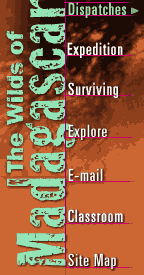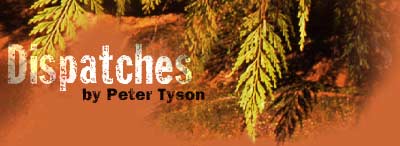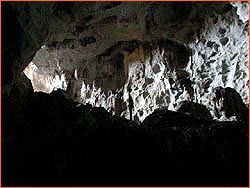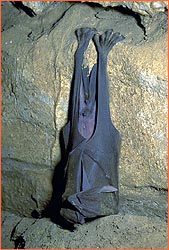 |
  Hear the bats
Hear the bats inside Bat Cave in RealAudio 56k | ISDN Get RealPlayer software |
 May 24, 2000 Bat Cave
Inside the cave was moist and smelled strongly of bat guano. We followed the squeals of bats coming from down deep in a pitch-black pit, being careful not to lose our footing on the slick rocks. Reaching the pit, we turned our headlamps upward, illuminating hundreds of pairs of amber orbs many tens of feet above us. These natural headlights moved with the swaying of the bats, which dangled by their feet from the ceiling. We listened as the squeals repeatedly built to a crescendo, then died away. I was careful not to look straight up, because now and then I heard a splat as freshly minted bat poop hit the rocks near me; occasionally I also felt a fine shower on my bare arms: bat pee. As the sun dropped below the horizon, the squeals took on a sense of urgency, though the few bats that had actually taken to the air inside the cave flew with a marked unhurriedness, flapping their wings slowly as they wheeled around the vast space. Periodically I'd hear what sounded like a bat wing slapping against rock. Do bats go bump in the night?
"One is go," Angeluc suddenly said, pointing up towards the sky, where he had seen the pioneer bat cross the lip. What distinguishes that first bat from all the others, I wondered? I looked up and saw what may have been the very same bat coming back over the lip. "He just came back," I said, pointing. For some reason Angeluc found that hilarious. His loud, head-shaking laugh is infectious, and soon I was laughing too. Then another and another flapped out into the increasing night, sometimes right over our heads. By the time it was dark enough to need a headlamp to write in my notebook, we could see hundreds of bats at any one moment silhouetted against the still-white sky. It seemed amazing they were mammals, just like us. With those squeals, which brought to mind something a rubber toy might make when squeezed, they reminded me more of E.T.
When I was out of sight of the entrance, I turned off my headlamp. In the pure cave darkness, my eyes became useless, heightening the other senses. The stink of bat guano was almost overpowering, but I listened with pleasure to the wind-in-the-treetops rush of flying bats. We stayed at Bat Cave until the great majority of the bats, from the sound of it, had headed out to feed in the bug-rich savanna. By then it was completely dark, and we had to make our way even more delicately over the tsingy blocks. If only we could have just taken flight with the bats. Peter Tyson is Online Producer for NOVA. Check back in tomorrow as we join Luke Dollar in his search for the fossa. Tonight we had an auspicious sign: just after dinner Dollar spotted a young fossa near one of his traps. Dispatches Forest of Hope (June 7, 2000) A Great Day for Silkies (June 4, 2000) Camp Life Unveiled (June 3, 2000) Three Hours with the Silkies (June 1, 2000) Angels of Marojejy (May 31, 2000) Wildlife (May 30, 2000) Into the Marojejy Massif (May 28, 2000) Croc Cave (May 26, 2000) Fossa! (May 25, 2000) Bat Cave (May 24, 2000) Update: English Camp (May 23, 2000) Update: Sunken Forest (May 21, 2000) Update: Night Walk (May 20, 2000) Update: 70 Feet Up (May 19, 2000) Update: Tropical Downpour (May 18, 2000) Photos: (1,2) Peter Tyson; (3) David Parks/library photo. The Expedition | Surviving The Wilds | Explore Madagascar Dispatches | Classroom Resources | E-Mail | Resources Site Map | The Wilds of Madagascar Home Editor's Picks | Previous Sites | Join Us/E-mail | TV/Web Schedule About NOVA | Teachers | Site Map | Shop | Jobs | Search | To print PBS Online | NOVA Online | WGBH © | Updated November 2000 |
 The yawning entrance to Bat Cave dwarfs Malagasy guide Angeluc Razafimanantsoa.
The yawning entrance to Bat Cave dwarfs Malagasy guide Angeluc Razafimanantsoa.
 View from within Bat Cave, looking towards the entrance as the sun set on the savanna outside.
View from within Bat Cave, looking towards the entrance as the sun set on the savanna outside.
 This fruit bat, hanging in a cave in the Ankarana, has a wingspan of approximately two feet.
This fruit bat, hanging in a cave in the Ankarana, has a wingspan of approximately two feet.